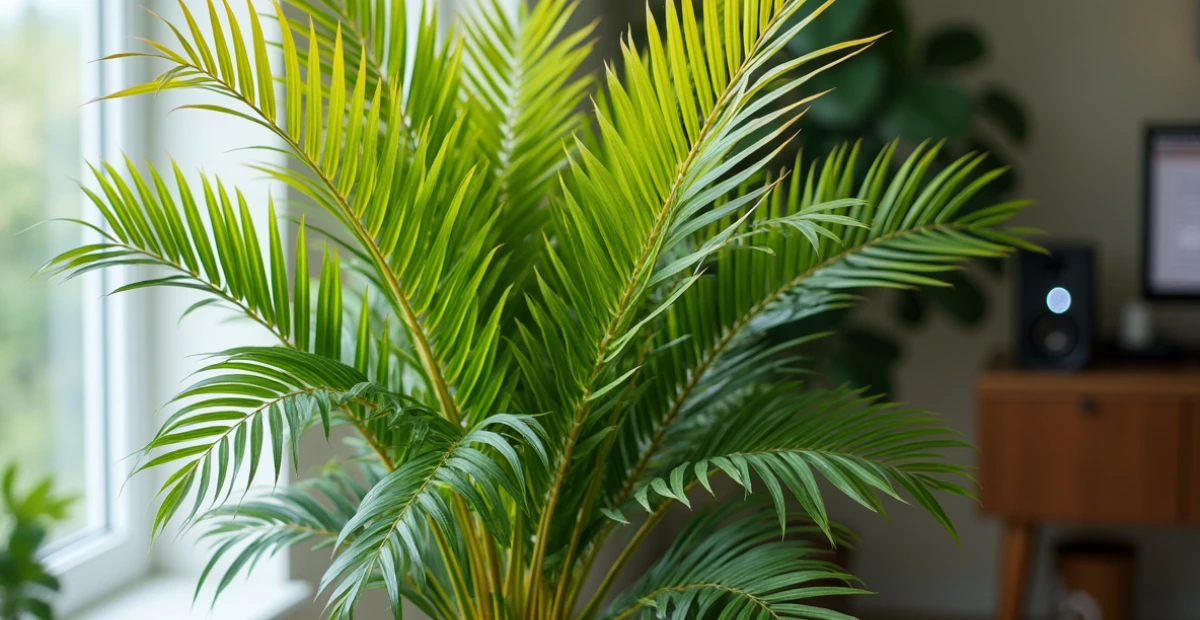Do you love having vibrant greenery in your home but find it challenging to keep certain plants healthy? You’re not alone! Many plant lovers, especially those new to tropical plants, struggle with maintaining the beauty of their indoor gardens. The Chrysalidocarpus Lutescens, or the Areca Palm, is one such plant that can be tricky to care for if you’re not familiar with its specific needs. However, with the right care, this stunning palm can thrive, bringing life and freshness to your space. In this article, you’ll discover 3 easy ways to keep your Chrysalidocarpus Lutescens thriving—no matter your level of plant care expertise.
advertisement
Introduction: Why Chrysalidocarpus Lutescens is Worth the Effort
Imagine stepping into your living room, the soft sway of lush green fronds beckoning you in. The graceful, feathery fronds of the Chrysalidocarpus Lutescens can instantly elevate the mood of any space. Not only does it brighten up your home, but it also helps purify the air, making it a functional as well as an aesthetic addition.
However, many plant enthusiasts face challenges in keeping this palm healthy. Whether it’s yellowing leaves, drooping fronds, or simply a lack of growth, it can be frustrating when your plant isn’t thriving. But don’t worry! With the right knowledge, you can easily overcome these challenges and maintain a thriving Chrysalidocarpus Lutescens in your home. Let’s dive into the key care strategies that will make a difference.
Understanding Chrysalidocarpus Lutescens Care Needs
Before jumping into care tips, it’s essential to understand the plant’s natural needs. The Chrysalidocarpus Lutescens is a tropical plant that thrives in environments similar to its native habitat. This knowledge will guide you in providing the ideal conditions for your palm to thrive indoors.
Ideal Growing Conditions for Chrysalidocarpus Lutescens
Chrysalidocarpus Lutescens, like many tropical plants, requires specific conditions to grow well. These conditions include the right balance of temperature, humidity, light, and water.
advertisement
- Temperature: The ideal temperature range for Chrysalidocarpus Lutescens is between 60°F to 75°F (16°C to 24°C). Anything too hot or too cold can affect its growth. Try to avoid placing it near drafts, radiators, or air conditioners, as temperature fluctuations can stress the plant.
- Humidity: Native to tropical regions, this palm enjoys moderate to high humidity. Dry air can cause its fronds to brown and wilt. Consider using a humidifier, placing your palm near other plants, or even using a humidity tray (a shallow tray filled with pebbles and water) to maintain the right moisture levels.
- Light: Chrysalidocarpus Lutescens loves bright, indirect light. Direct sunlight can burn its delicate fronds, while too little light can slow growth and lead to pale, drooping leaves. Place your palm near a window with sheer curtains or in a spot that receives filtered sunlight throughout the day.
- Watering: This palm prefers moderate watering. It’s important not to overwater, as Chrysalidocarpus Lutescens is susceptible to root rot. Allow the top few inches of the soil to dry out before watering. Check the soil with your fingers, and always ensure the pot has good drainage to prevent water from accumulating at the bottom.
Common Problems and How to Avoid Them
Every plant can encounter issues, and Chrysalidocarpus Lutescens is no exception. Understanding the common problems this palm faces—and how to address them—will keep your plant looking its best.
- Yellowing Leaves: If your palm’s leaves start turning yellow, it could be a sign of overwatering, underwatering, or low humidity. Ensure that you’re watering appropriately and providing enough moisture in the air.
- Brown Tips: The tips of the fronds may turn brown due to dry air, too much direct sunlight, or over-fertilization. Adjust the plant’s environment by increasing humidity, moving it to a location with indirect light, and reducing fertilization during the fall and winter.
- Drooping Fronds: This could indicate poor light, irregular watering, or root problems. If the plant is too far from a light source, relocate it to a brighter spot. Also, maintain a regular watering schedule to avoid any stress on the roots.
Understanding these issues and their solutions is key to keeping your Chrysalidocarpus Lutescens healthy and vibrant.
advertisement
3 Easy Ways To Keep Your Chrysalidocarpus Lutescens Thriving
Now that you know the basic care needs, it’s time to implement 3 simple strategies that will ensure your Chrysalidocarpus Lutescens thrives.
1. Proper Watering: The Key to Palm Health
Watering is one of the most crucial aspects of Chrysalidocarpus Lutescens care. Too much water can drown the roots and lead to root rot, while too little water will cause the plant to dry out. Here’s how to get it right:
- How Often Should You Water? Check the top 2-3 inches of soil. If it feels dry to the touch, it’s time to water. If it still feels moist, wait a few more days.
- Avoid Standing Water: Ensure your pot has proper drainage to avoid water accumulating at the bottom. Watering from the top is best, but let the water drain fully before placing the pot back in its saucer or decorative pot.
- Tip: Consider using a moisture meter for more accurate readings of soil moisture levels.
By following these steps, you’ll help your Chrysalidocarpus Lutescens develop strong roots and lush, healthy fronds.
2. Providing the Right Light
Lighting is another crucial factor for your palm’s success. Too much sunlight will scorch its delicate fronds, while too little will stunt growth. Here’s how to strike the perfect balance:
- Bright, Indirect Light: Place your palm near a bright window but avoid direct sunlight. Direct sun can burn the leaves, causing them to turn brown or crispy.
- Rotate Your Palm: To ensure even growth, rotate your plant every few weeks so that all sides receive adequate light.
- Supplement with Grow Lights: If you don’t have a space with enough natural light, consider investing in a grow light to help your plant thrive indoors.
Providing the right light conditions will prevent common issues such as slow growth or pale leaves, ensuring your Chrysalidocarpus Lutescens stays vibrant.
advertisement
3. Boosting Humidity for Thriving Fronds
Humidity is another essential element in keeping your Chrysalidocarpus Lutescens healthy. Without enough moisture in the air, your palm may start showing signs of stress, such as brown fronds and drooping leaves. Here are a few ways to boost humidity:
- Mist Regularly: Lightly mist your palm’s fronds with water every few days to add moisture to the air around it.
- Use a Humidifier: A humidifier is an effective way to maintain consistent humidity levels, especially during dry winter months.
- Humidity Tray: A simple solution is to place your palm on a humidity tray—a shallow tray filled with pebbles and water. This creates a localized humidity zone around your plant.
By maintaining high humidity levels, you’ll promote healthy growth and vibrant fronds for your Chrysalidocarpus Lutescens.
Additional Tips for Thriving Chrysalidocarpus Lutescens
Caring for Chrysalidocarpus Lutescens doesn’t stop at watering, light, and humidity. There are several other tips that can ensure your palm stays healthy and strong.
Fertilizing for Growth
Feeding your Chrysalidocarpus Lutescens with the right fertilizer is important to encourage healthy growth, especially during the growing season.
- When to Fertilize: Feed your palm during the spring and summer when it’s actively growing. In the fall and winter, reduce fertilizing, as the plant enters a dormant phase.
- Best Fertilizer: A balanced liquid fertilizer with equal parts nitrogen, phosphorus, and potassium is ideal. Dilute the fertilizer to half-strength to avoid overfeeding.
Regular fertilization will keep your palm lush and strong, helping it reach its full potential.
advertisement
Repotting for Healthy Roots
Over time, your Chrysalidocarpus Lutescens will outgrow its pot. Repotting ensures that it has enough space for its roots to develop properly.
- When to Repot: Repot your palm every 2-3 years or when you notice roots growing through the drainage holes.
- Choose the Right Pot: Select a pot that’s 1-2 inches larger in diameter than the current pot. Ensure it has drainage holes to prevent waterlogging.
Repotting will refresh your palm’s growing conditions, ensuring it continues to grow healthy and strong.
Pruning and Cleaning
Regular pruning and cleaning keep your Chrysalidocarpus Lutescens looking its best.
- Pruning: Remove yellow or dead fronds to encourage healthy new growth. Always prune with clean, sharp scissors to avoid damaging the plant.
- Cleaning the Leaves: Dust can accumulate on the fronds, blocking sunlight and hindering photosynthesis. Clean the leaves regularly with a damp cloth to remove dust.
Pruning and cleaning are simple tasks that will keep your palm looking fresh and vibrant.
Quick Care Table for Chrysalidocarpus Lutescens
| Care Aspect | Ideal Conditions |
|---|---|
| Light | Bright, indirect light |
| Watering | When top 2-3 inches dry |
| Temperature | 60-75°F (16-24°C) |
| Humidity | Moderate to high humidity |
| Fertilizing | Balanced liquid fertilizer, spring to summer |
| Repotting | Every 2-3 years |
Conclusion: Keep Your Chrysalidocarpus Lutescens Thriving!
By following these 3 simple steps—proper watering, providing the right light, and boosting humidity—you can ensure that your Chrysalidocarpus Lutescens thrives in your home. With a little attention and care, this stunning palm will bring beauty, freshness, and a sense of tranquility to your indoor space.
advertisement
Ready to give your palm the care it deserves? Start implementing these tips today, and watch your Chrysalidocarpus Lutescens grow strong, healthy, and vibrant!
FAQ: All Your Chrysalidocarpus Lutescens Questions Answered
How often should I water my Chrysalidocarpus Lutescens?
Water when the top 2-3 inches of soil are dry to the touch. Avoid overwatering, as this can cause root rot.
Can my Chrysalidocarpus Lutescens survive in low light?
While it can tolerate low light, Chrysalidocarpus Lutescens thrives best in bright, indirect light.
Why are the tips of my Chrysalidocarpus Lutescens turning brown?
Brown tips are usually a sign of dry air, over-fertilization, or too much direct sunlight. Increase humidity and adjust the plant’s light exposure.
How do I increase humidity for my Chrysalidocarpus Lutescens?
Use a humidifier, mist the leaves, or place your palm on a humidity tray to create a more humid environment.
advertisement
By following these care tips and incorporating these solutions, you’ll have a thriving Chrysalidocarpus Lutescens in no time! Keep the faith, and your palm will reward you with its vibrant beauty.


